Hiring Alert: We’re on the hunt for a freelance worker!
Not included: A PhD degree with 10 years of working experience.
What we’re looking for:
Passion > Experience
Creativity > Degree
Hustle > Everything else
Sounds familiar?
You’ve probably seen job posts like this all over the internet because freelancing is booming.
More and more people are choosing to work for themselves (in online or more traditional settings).
But what exactly is freelancing? And how do people make it work without a boss?
That’s exactly what we’re diving into today.
In this blog, we’ll break down what freelancing means, how freelancers work (without an employer), the pros and cons, and the best platforms to find freelance work.
So, if you’ve ever wondered how people manage to earn without a paycheck and stick 9-to-5, this is for you.
What Is a Freelance Job?
The word “freelance” came from medieval times when mercenary soldiers called “free lances,” used to fight for whoever paid them.
They didn’t serve a single king or country. They were hired guns who sold their skills to the highest bidder.
Coming from this origin, a freelance job now means working for YOURSELF instead of having a fixed boss.
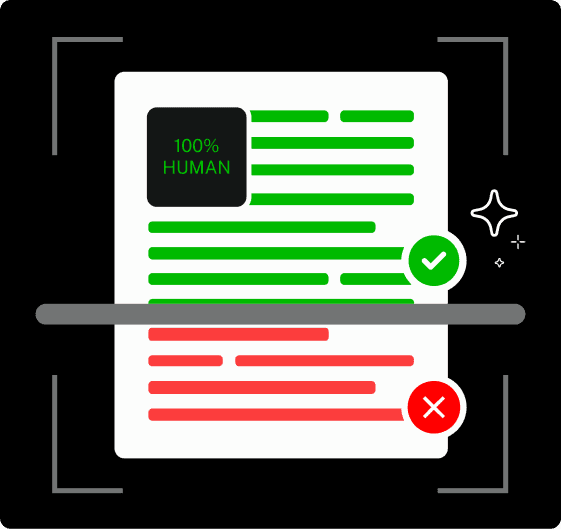
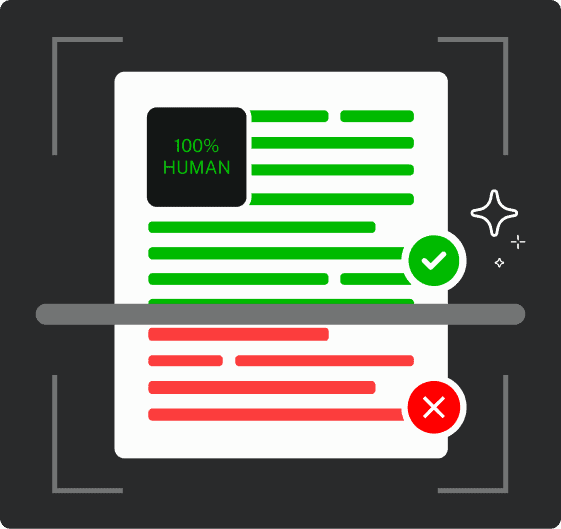
Never Worry About AI Detecting Your Texts Again. Undetectable AI Can Help You:
- Make your AI assisted writing appear human-like.
- Bypass all major AI detection tools with just one click.
- Use AI safely and confidently in school and work.
You work as a self-employed professional who provides services to many different clients.
- It’s different from contracting which involves working with one company for a set period (like six months).
- It’s also different from gig work which involves short, one-off tasks through apps like Ubber or DoorDash.
- Freelancers handle longer projects and juggle multiple clients at once.
Freelancing exploded in 2019 when about 162 million people worldwide were doing freelancing – making 9% of the global workforce.
By 2025, that number is expected to reach 216 million, making up 12% of all workers.
How Freelancers Work Without a Fixed Employer
Unlike employees, freelancers aren’t told how or when to work because they don’t have a boss.
Clients only care about getting good results by the agreed deadline.
For this, your job might have a clear start and end point.
For example,
- A writer might be hired for five blog posts over a period of 2 weeks.
- A designer might be asked to create a logo in the next 24 hours.
Once the project is done, they get paid and move on with one client – unless the client hires them again. But freelancing isn’t just about a single project and cashing in.
A freelancer has to manage multiple clients, juggle deadlines, meet expectations, and manage the cash flow.
Speaking of cash flow, freelancers also handle everything employers usually take care of.
It includes taxes, health insurance, and organizing their schedule.
Legally, they’re independent contractors, not employees, meaning they don’t get any paid vacation or benefits.
But they’ve got something better and guess what this is? FREEDOM.
They don’t have to beg for a weekday off to visit their aunt’s house. They have the freedom to choose their projects, set their rates, and work on their own terms.
Common Industries That Hire Freelancers
Here are some common industries that are experiencing the fastest growth in the freelance market.
1 – Creative & Design Field
Creative jobs are probably what most people think of first when they hear “freelance.”
For example, it includes writers who create blog posts, articles, and books for clients. Designers make logos, websites, and ads.
Photographers take pictures for magazines, weddings, or product websites.
2 – Technology & Digital Services
Tech is a huge field for freelancers right now. For example, programmers build apps and software. Web developers create and fix websites.
Digital marketers help businesses get noticed online through social media and ads.
The pay in tech freelancing is often really good, but you have to keep learning new skills all the time or you’ll fall behind.
Sometimes that makes me feel excited, other times completely overwhelmed.
3 – Professional Consulting & Finance
Professional services might surprise you, but many consultants, accountants, and even lawyers work as freelancers.
They help businesses solve problems, manage money, or deal with legal issues.
These jobs usually need special training or certificates, but they can pay very well.
4 – Media & Entertainment
The media and entertainment world runs on freelancers. This includes journalists, video editors, voice actors, musicians, and podcast producers.
The jobs can be super fun and creative, but the work isn’t always steady.
Some months you’re too busy to sleep, and then suddenly you might have no projects at all.
It’s definitely not for people who need a predictable life.
Emergency High-Growth Sectors
The fastest-growing freelance fields include:
- Artificial intelligence (36.6% CAGR from 2023-2033)
- Cybersecurity (CAGR of 12.3% from 2023 to 2030.)
- Data science (CAGR of 42% from 2023-2033).
How Do Freelance Jobs Work?
Freelance jobs might not have a clear schedule but they do have a 5-step clear pattern.
1 – Discover
This is when you first talk to a potential client about what they need.
Sometimes clients know exactly what they want, but often they’re confused and need your help figuring it out.
It can be frustrating when they say things like “make it pop” or “I’ll know it when I see it” without giving clear details.
2 – Proposal Writing
The next step is writing a proposal.
This is basically your plan for the work and how much it will cost.
Good clients respect fair prices, and the trouble-makers are usually the biggest headaches anyway.
So don’t under-price your work just because you don’t want to lose the client.
3 – Signing a Contract
Once a client agrees to your proposal, you both sign a contract.
This is super important, even though it might feel awkward to ask for one.
The contract protects both of you by clearly stating what work will be done, when it’s due, and how much you’ll get paid.
4 – Execution
This is actually doing the work you promised.
This is usually the fun part.
You get to use your skills to create something valuable.
But it can also be stressful when you hit roadblocks or realize you under-estimated how long something would take.
5 – Delivery
Finally, you deliver the finished work to the client.
Sometimes they love it right away. Other times, they ask for changes.
Most contracts include one or two rounds of revisions, but be careful about clients who keep asking for “just one more small tweak” forever!
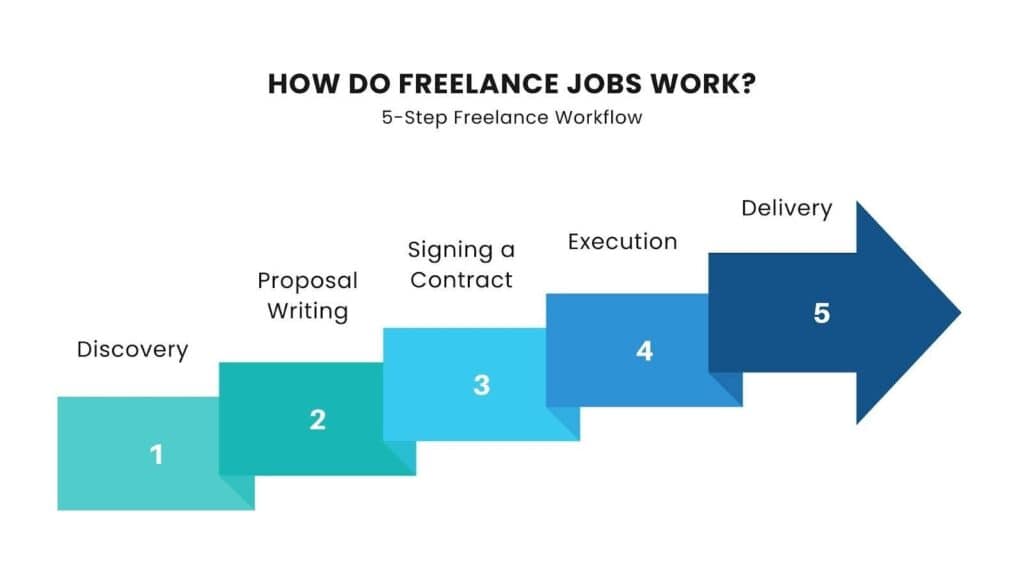
Being a great freelancer isn’t just about having top-notch skills.
It’s about delivering—every time.
And that takes more than talent. Communication, organization, and the right tools can make or break your workflow.
Now, do you need a complex system to stay on top of things? Nope.
Some freelancers swear by Kanban boards and Agile sprints.
Others? A solid to-do list and a reliable calendar do the trick. Whatever works—as long as you deliver.
Speaking of delivering, let’s talk tools.
You don’t need a fancy tech stack.
In fact, you probably need fewer tools than you think. A few essentials:
- Slack for messaging
- Zoom for video calls
- Google Drive or Dropbox for easy file sharing.
Pro tip: Don’t fall for the “shiny tool” trap.
When I started, I spent way too much on software that looked impressive but didn’t actually help me work better.
Now? I stick to what truly boosts productivity—and ditch the rest.
How Freelancers Get Paid (Hourly, Per Project, Retainers)
Freelancers get paid in three main ways: hourly rates, project-based pricing, and retainer agreements.
Each has its pros and cons, and the right choice depends on the type of work, client needs, and income goals.
1 – Hourly Rates: Pay for Time Spent
With hourly pricing, freelancers charge for every hour worked.
Rates can vary widely—beginners might start at $10-$15/hour, while seasoned experts in high-demand fields can charge $100/hour or more.
This model is common for consultants, developers, and roles where the workload isn’t clearly defined upfront.
Pros: Predictable billing and easy to adjust if the project expands.
Cons: Income is tied to time, making it harder to scale. Tracking hours can also be tedious.
Many platforms like Upwork and Fiverr offer built-in time-tracking tools, making hourly billing more transparent for both freelancers and clients.
Project-Based Pricing: Value Over Time
Instead of charging by the hour, freelancers set a fixed price for a deliverable—like $100 for a logo, $3,000 for a website, or $2,000 for a marketing campaign.
Pricing is based on the value of the work rather than the time spent.
Pros: Encourages efficiency, offers higher income potential, and allows freelancers to take on multiple projects at once.
Cons: If the scope of work isn’t clear, projects can take longer than expected without additional pay (aka “scope creep”).
To avoid this, many freelancers use milestone payments—getting paid in stages as different parts of the project are completed.
Retainer Agreements: The Best of Both Worlds
A retainer is like a monthly subscription where a client pays a set amount for ongoing services.
For example, a company might pay $2,000/month for 20 hours of design work. This model is popular in marketing, consulting, and web maintenance—any field where ongoing support is needed.
Pros: Provides predictable income, reduces the time spent finding new clients, and builds long-term relationships.
Cons: Requires consistent performance to keep the contract going.
Regardless of how freelancers charge, securing payments is essential:
Payment Platforms
- PayPal (widely used but takes ~3% in fees)
- Stripe (great for online payments)
- Wise (cheaper for international transfers).
Invoicing Tools:
- FreshBooks
- Wave
- QuickBooks helps track payments and keep things organized.
Pros & Cons of Being a Freelancer
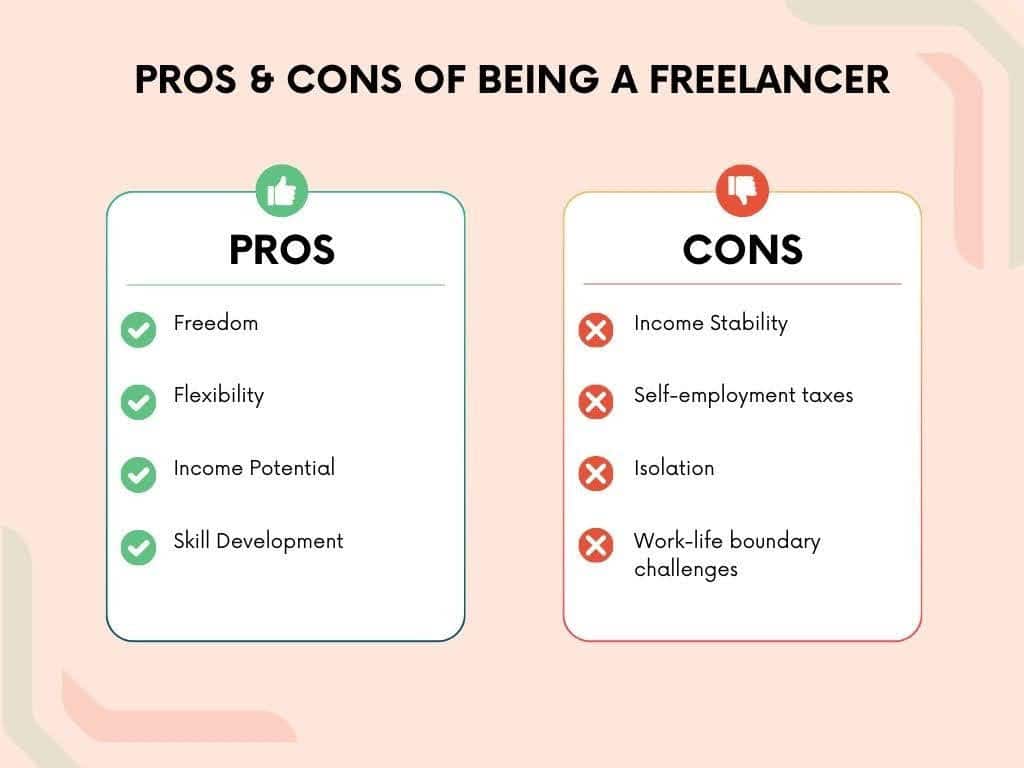
Freelancing has its perks—flexibility, freedom, and being your own boss. But let’s be real, it’s not all sunshine and coffee shop workdays.
One of the biggest struggles? Loneliness.
When you don’t have coworkers to chat with or an office to go to, work can start to feel isolating.
Then there’s work-life balance—or lack of it.
When your office is also your living room, it’s way too easy to check emails at midnight or keep working through the weekend.
If you’re thinking about freelancing, go in with your eyes open.
Freedom is amazing, but it comes with real challenges—both financially and mentally.
Best Freelance Job Categories & Industries
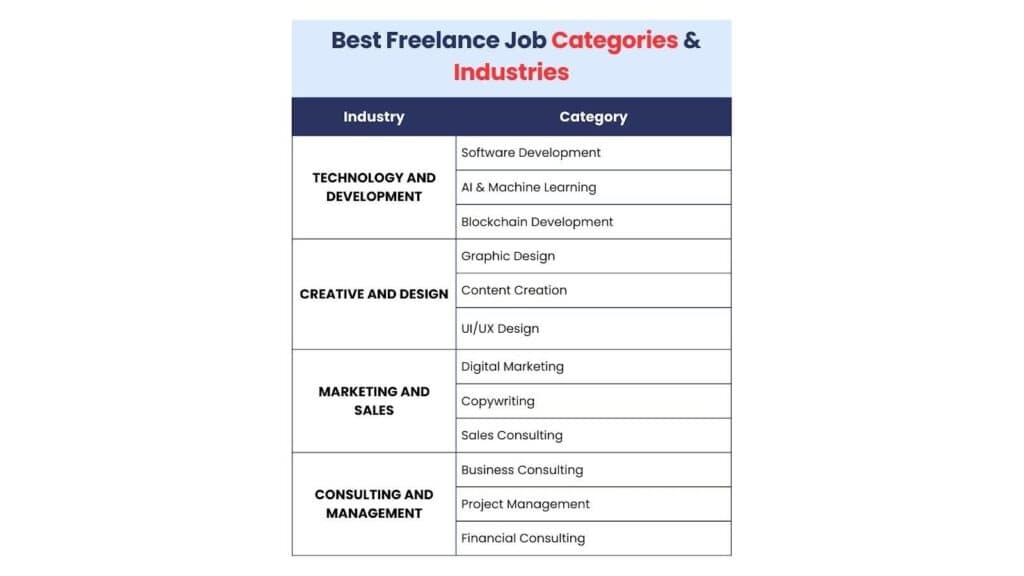
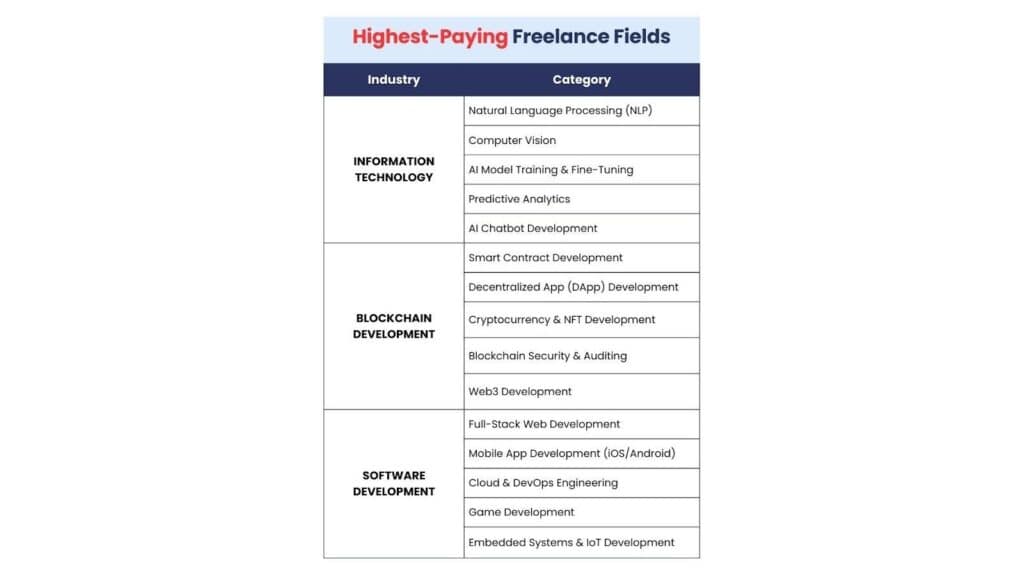
Where to Find Freelance Jobs (Best Platforms)
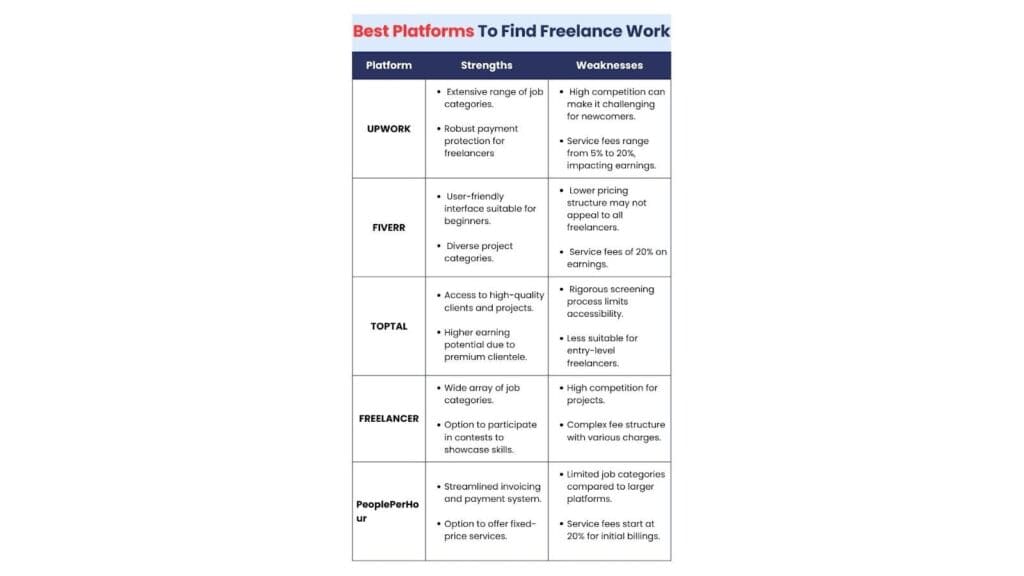
Of course, relying solely on platforms isn’t the only way to land work.
Cold outreach—reaching out directly to potential clients—remains one of the most effective strategies for freelancers looking to build long-term relationships.
The numbers speak for themselves: the average open rate for cold emails is around 15-25%.
The response rate sits at about 8%, but including 1-3 well-placed questions in your message can increase replies by another 48.39%.
And if the first email doesn’t get a response?
Following up is key.
A well-timed sequence of 2-3 follow-ups significantly improves the chances of hearing back.
How to Get Started as a Freelancer (Step-by-Step)
1. Identify Your Skills & Strengths
Everyone has a skill that makes them special.
Maybe you’re great at design, can write killer content, or know how to code well.
The first step is understanding what you’re good at.
- What do people always ask me to help with?
- What comes naturally to me?
- What skills have I collected over the years?
Just because you’re good at something doesn’t mean it’ll pay the bills.
For example,
If you’re great at graphic design but the market is oversaturated with logo designers, you might need to niche down (e.g., packaging design for e-commerce brands).
But what if you have no skills?
You can learn. Pick one skill, go deep, and commit to getting good at it. Here’s how:
- Choose a high-demand skill – Look at trends. Copywriting, video editing, coding, and UX design are always in demand.
- Use free & low-cost resources – YouTube, Coursera, and Udemy.
- Practice daily – Apply what you learn. Build a simple website, write articles, design logos—just start.
2. Build a Strong Freelance Resume & Portfolio
Your portfolio is a movie trailer of your professional life. It needs to be so good that clients can’t wait to “watch the full movie” by hiring you.
What makes a killer portfolio?
- Clean, organized presentation
- Your best work (quality over quantity)
- Clear examples that show your range
- Client testimonials (even if they’re from small projects)
Once the portfolio part is done, next is building a resume.
Resume is important because when clients post a job, they’re flooded with applications.
They don’t have time to guess who’s the best fit. Your resume is what helps them quickly decide whether you’re worth their time.
And a lot of people make it very complicated. Here’s how you can create a freelance-friendly resume in under 2 minutes.
- Visit the website page of AI Resume Builder and sign up.
- Scroll down a list of templates depending upon your field or career demand.
- Add in your details.
- Let AI generate a keyword-optimized resume for you.
- Download and save in 2-3 places for quick sending.
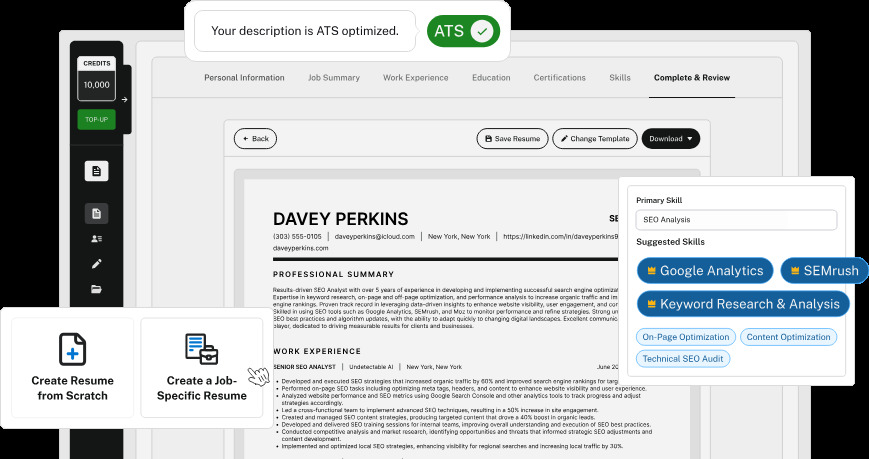
3. Apply for Jobs & Send Proposals Efficiently
To send applications daily or multiple times a day, you can’t afford to spend 2-3 hours each time.
To streamline the process, use Smart Applier. Simply follow these three steps:
- Connect your resume or LinkedIn profile with the tool.
- Customize the search criteria and set filters so the AI knows which jobs you’re looking for.
- Smart Applier will automatically apply to relevant jobs for you.

Most freelancers don’t get jobs because they send generic applications.
Put yourself in the shoes of a recruiter and ask yourself…
If I’ve been hiring for the role, would I accept something like,
“I’d love to work with you”
…or would you consider a proposal with
“I noticed you’re looking for a copywriter with experience in e-commerce. I recently helped a Shopify brand increase conversions by 35%—I’d love to do the same for you.”
You know the answer. To get noticed and hired, you need to write personalized proposals. Here’s an example:
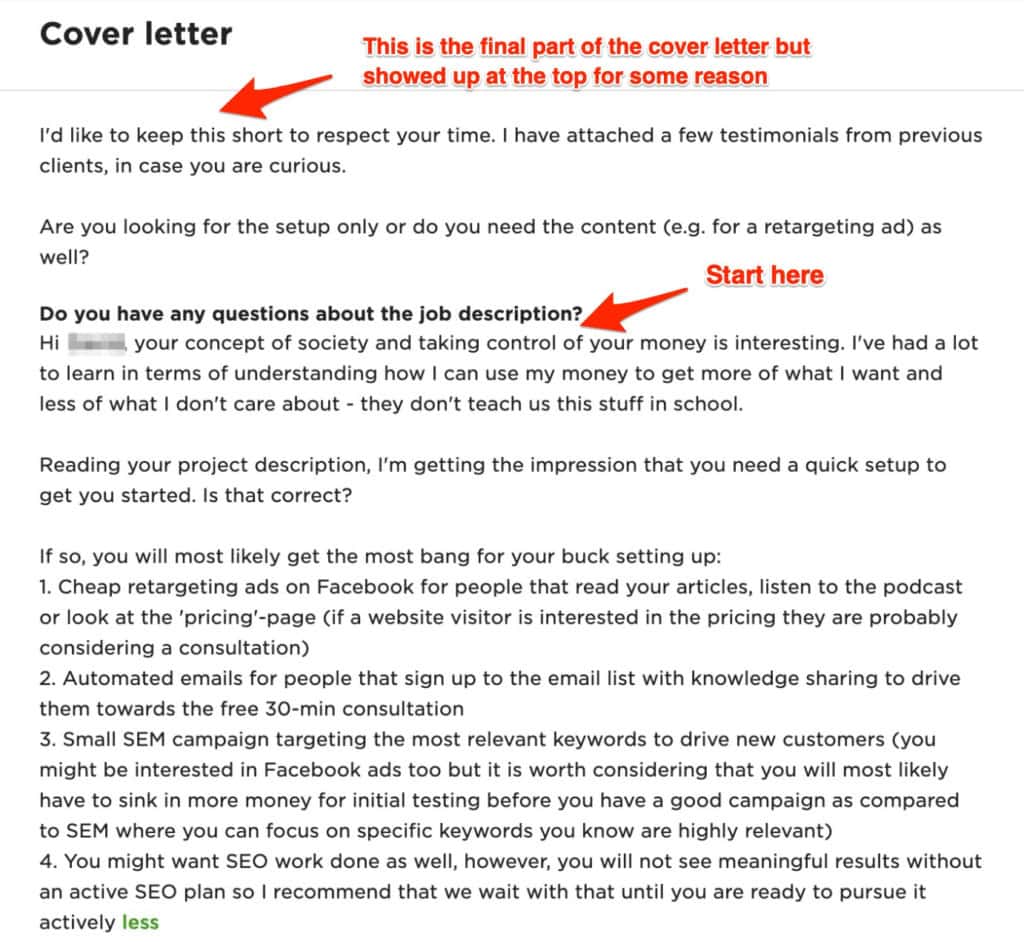
Source = Milo.co
>> To learn more about how to write a proposal, read this blog.
4. Craft a Professional Cover Letter for Clients
A great cover letter is a bridge. On one side, there’s you. On the other side, there’s the client.
Your job is to build a rock-solid connection.
So how do you build this connection?
There are two steps to follow.
1 – Know the Client Better Than They Know Themselves
Every client has a problem. Your mission is to present yourself as a solution. So how can you do this?
- Read the job description like a detective
- Research the company’s background
- Understand their specific challenges
Once this is done, the next step is to write a personalized cover letter.
2 – Use AI Cover Letter Generator To Write Personalized Letters For You
You can use the AI Cover Letter Generator for this purpose and save upto 30 minutes of your time doing it manually.
Using it is extremely simple.
Step # 1 – Fill in personal details. (Full name, email address, experience, and niche).
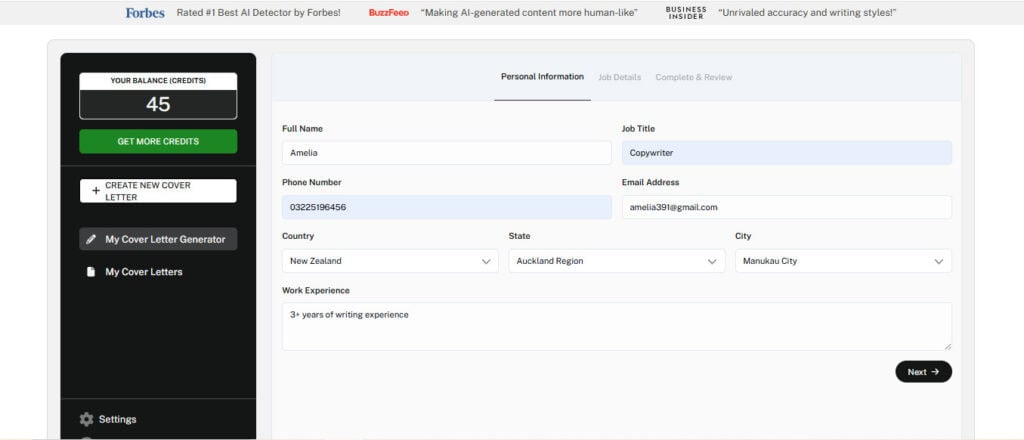
Step # 2 – Fill in the job details (Target company, job role, and job description).
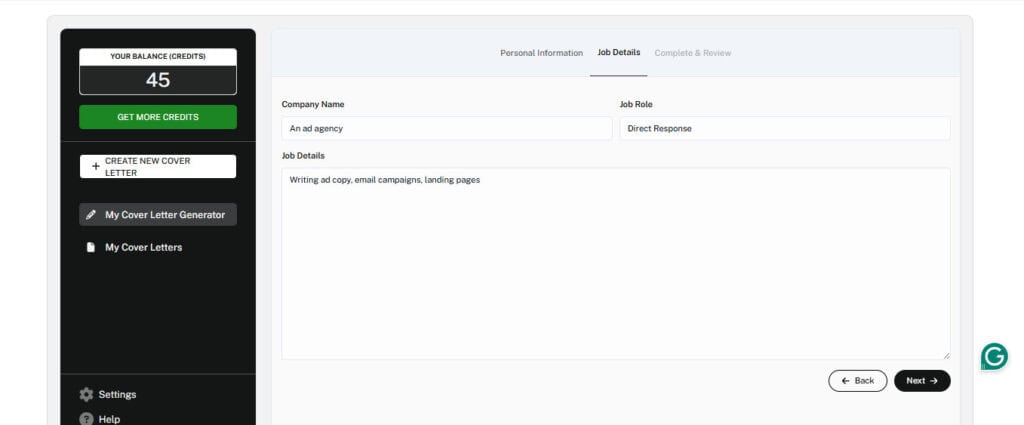
Step # 3 – Wait for the tool to generate a customized proposal for you. (it will not take more than 10-12 seconds).
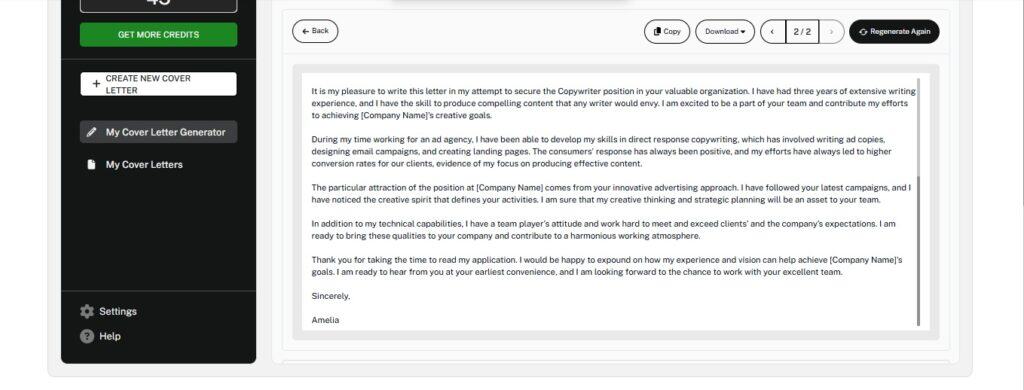
5. Set Competitive Rates & Manage Your Income
Pricing yourself is tricky.
Charge too low, and you’ll feel overworked.
Charge too high without proof of value, and clients will ghost you.
So what’s the trick?
Know what the market pays and positioning yourself accordingly.
For example,
Instead of saying, “I’ll design this for $200,”
Say, “I’ll create a brand identity that helps increase your sales.”
People pay for results, not time.
6. Deliver Quality Work & Build Client Relationships
Getting a client is one thing. Keeping them is another.
The best freelancers don’t just do the work—they make the process smooth, communicate clearly, and deliver beyond expectations.
Clients will always ask for revisions. It’s part of the game.
Instead of taking it personally, see it as a way to build trust.
Also, don’t just complete a project and disappear—follow up, ask how things are going, and offer additional help. This is how you turn one-time clients into long-term ones.
While you’re at it, explore our AI Detector and Humanizer in the widget below!
Final Thoughts: Is Freelancing Right for You?
Freelancing isn’t a shortcut to easy money. It’s still work—just a different kind.
Think about those medieval “free lances” – mercenaries who fought for the highest bidder.
Today, the battlefield has changed. Your weapon isn’t a lance, but your laptop, your creativity, and your drive.
So, here’s the real question: Are you built for this ride?
Freelancing gives you freedom—choosing your projects, setting your schedule, working from anywhere.
But it also demands something most 9-to-5 jobs don’t: Full responsibility for your success.
Are you ready to take the reins and build your own career?
The freelance world is waiting. Your skills are the ticket. Your passion is the fuel. And your journey… well, that’s about to get incredibly interesting.
The only wrong move is not moving at all!
